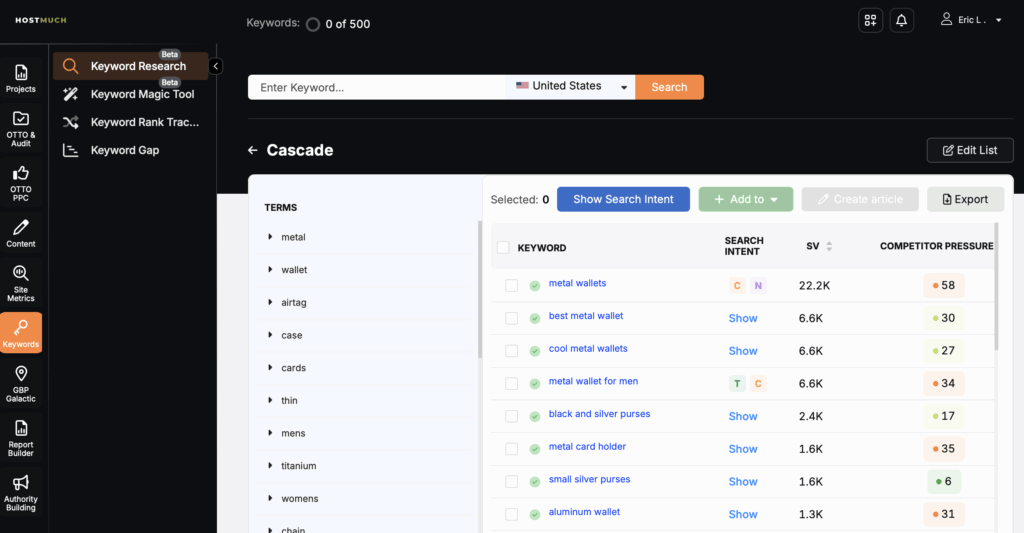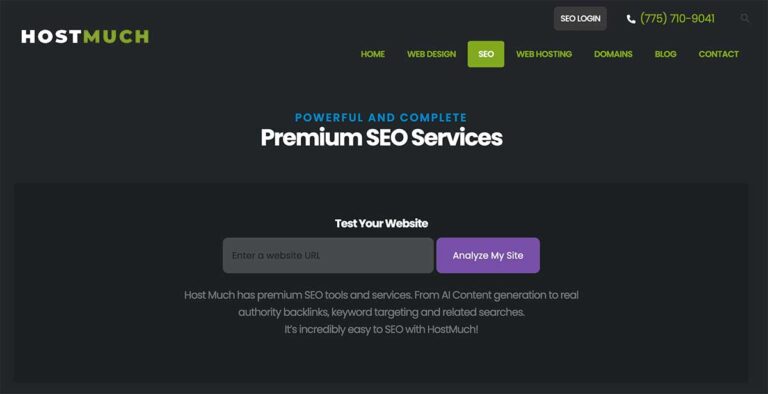Master Keyword Research for Higher Search Visibility

Master Keyword Research for Higher Search Visibility: A Complete Guide for Businesses
Search Engine Optimization (SEO), like any other business decision, should start with a well thought out plan. The first set to developing that plan should be keyword research. Discover how mastering keyword research can dramatically improve your search visibility, drive targeted organic traffic, and convert visitors into clients. Many startups and small businesses struggle to rank for valuable search queries, leading to low discovery and stalled growth. In this guide, you will learn precise methods to identify high-value keywords, understand user intent, leverage powerful tools, implement advanced strategies, and measure performance metrics. We will cover:
- What keyword research is and why it’s essential.
- A step-by-step research process for business growth.
- Advanced tactics—long-tail, local, voice, and competitive insights.
- Integrating keywords into SEO, content marketing, and link building.
- Monitoring KPIs, analytics, and optimizing for SERP features.
- Future trends—AI, E-A-T, semantic search.
- How HostMuch’s SEO services support your keyword strategy.
What Is Keyword Research and Why It’s Essential for Higher Search Visibility?

Keyword research is the process of identifying the exact words and phrases your target audience uses when searching online to ensure your content aligns with user queries, boosts relevance signals, and increases organic visibility. By mapping search volume and competition levels, businesses can prioritize high-impact terms that attract qualified traffic and improve ranking potential. For example, a local bakery targeting “gluten-free cupcakes near me” can capture niche intent and drive conversions more effectively than broad terms like “bakery.”
As you can see from the above example, one of our clients, Cascade Custom Creations sells laser engraved metal wallets. Keyword research in our HostMuch SEO Tool show that “metal wallets” has 22,200 searches per month with 58/100 on competition. Ideally, we would like to rank our client on this, but starting out, it’s best to go for the low hanging fruit. “cool metal wallet”, “best metal wallet”, “metal wallet for men”, etc…
Using one high-volume keyword means you’re targeting a search term with a large audience and potentially high traffic, but also strong competition. If you rank well for it, you can get a big influx of visitors — but your traffic can fluctuate more due to competitive shifts and algorithm changes.
By targeting three lower-volume keywords, you spread your reach across multiple, less competitive search terms. Each one might bring in fewer visitors individually, but combined, they can match or exceed the traffic from a single high-volume term. More importantly, they tend to be more stable because if one keyword drops in ranking, the others can still sustain your organic traffic.
This approach is like diversifying investments — one big win can be valuable, but spreading your effort across several smaller wins gives you a steadier and more reliable return.
How Does Keyword Research Influence Search Engine Rankings?
Keyword research plays a central role in determining how well your website ranks in search engines because it aligns the language of your on-page content with the criteria search algorithms use to evaluate relevance, authority, and user engagement. When executed effectively, it doesn’t just help you get found — it ensures that the right audience finds you. This makes keyword research for your target market one of the most critical components of any successful search engine optimization (SEO) strategy.
Relevance Matching
At its core, keyword research ensures that the terms you use in your content match the exact queries people type into search engines. Search algorithms analyze text, headings, metadata, and even image alt tags to determine if your page answers a user’s question. By selecting the right keywords — including primary, secondary, and long-tail variations — you increase the likelihood that your content appears for searches that matter most to your business. The closer your keyword usage aligns with a searcher’s intent, the more likely you are to earn a higher ranking and relevant clicks.
Quality Signals
Search engines also look for quality indicators, and targeted keywords can help strengthen those signals. When your title tags, meta descriptions, and headings feature relevant terms, you improve the chances of attracting clicks from search engine results pages (SERPs). This in turn can boost your click-through rate (CTR), a positive engagement metric that algorithms may consider as part of ranking signals. Once visitors arrive, well-matched content encourages them to stay longer — increasing dwell time and reducing bounce rates, both of which can further support stronger rankings.
Content Depth and Topical Authority
Keyword research isn’t just about picking individual words — it’s about understanding entire themes within your niche. By exploring related terms, synonyms, and semantic variations, you can build content that addresses a topic comprehensively. Search engines reward this depth by recognizing your site as a source of topical authority. For example, if you target “organic coffee beans,” you might also cover related terms like “fair trade coffee,” “single-origin roasts,” and “coffee brewing methods.” This broader coverage signals to search engines that you are an authoritative resource in your subject area, helping your pages compete more effectively for rankings.
When done well, keyword research becomes more than a technical SEO task — it becomes the blueprint for your entire content strategy. It ensures your website speaks the same language as your audience, provides depth that satisfies their questions, and delivers engagement metrics that search engines reward. The result is a stronger, more sustainable presence in search rankings that drives qualified traffic to your site. factors work together to elevate your pages in SERPs and sustain higher search visibility.
What Are the Core Types of Keywords: Head, Body, and Long-Tail?
Keywords fall into three main categories based on specificity and search volume:
* Long-tail terms often convert at 3–5% higher rates, making them essential for niche targeting and sustained growth.
How Does Understanding Search Intent Improve Keyword Selection?
User intent categorizes queries by purpose, guiding you to choose keywords that align with audience needs, improve engagement, and increase conversion rates.
- Informational: Seeking knowledge (e.g., “what is keyword research”).
- Navigational: Looking for a brand or site (e.g., “HostMuch SEO services”).
- Transactional: Ready to buy (e.g., “hire SEO consultant”).
- Commercial Investigation: Comparing options (e.g., “best keyword research tools”).
How to Conduct an Effective Keyword Research Process for Business Growth

An effective keyword research process provides a structured approach to search engine optimization. Use keyword research to uncover opportunities that drive targeted traffic and support growth objectives. It combines ideation, competitive analysis, tool utilization, metric evaluation, and strategic mapping to create a data-driven keyword portfolio.
What Are Seed Keywords and How Do You Brainstorm Them?
Seed keywords are foundational terms reflecting core business topics from which you expand into broader keyword sets. To generate seed ideas:
- List primary products and services.
- Review your website’s navigation and page titles.
- Survey customer queries and feedback.
- Analyze social media and forum discussions.
- Use LLM’s like Gemini, or ChatGPT
Drawing seed keywords from real customer language establishes a solid base for deeper research.
How to Perform Competitor Keyword Analysis to Gain an Edge?
Competitor keyword analysis reveals gaps and high-value opportunities overlooked by others. Follow these steps:
- Identify top competitors in SERPs.
- Extract their ranking keywords with our HostMuch SEO tool.
- Compare keyword difficulty and volume.
- Pinpoint missed long-tail or local terms.
This process uncovers hidden niches where you can out-rank competitors and capture incremental traffic.
How Does Competitor Analysis Inform Keyword Strategy?
Ongoing competitor analysis deepens insight into market shifts and emerging topics. By tracking rivals’ new rankings, content updates, and keyword expansions, you can:
- Rapidly seize trending terms.
- Identify under-served queries.
- Refine your targeting to maintain a competitive edge.
This continual feedback loop strengthens your strategic positioning in dynamic search landscapes.
Which Keyword Research Tools Should Businesses Use For Search Engine Optimization?

Several tools provide robust data for volume, difficulty, and competitive insights. Key options include:
How to Use Google Keyword Planner for Targeted Keyword Discovery
Google Keyword Planner uncovers keyword ideas and estimates metrics by:
- Entering seed terms or URLs.
- Filtering by location, language, and network.
- Reviewing columns for average monthly searches and competition.
This tool’s integration with Google Ads provides direct insight into how users search, forming a reliable dataset for SEO planning.
What Are the Benefits of Paid Services in Keyword Research?
Paid platforms like HostMuch SEO, SEMrush, Moz and Ahrefs offer advanced capabilities:
- Competitive Gap Analysis: Compare your domain against top rivals.
- Keyword Difficulty Scores: Prioritize terms by ranking feasibility.
- SERP Feature Tracking: Monitor featured snippets and PAA placements.
These insights enable businesses to craft a strategic keyword portfolio that targets both quick wins and long-term growth.
How to Analyze Keyword Metrics: Search Volume, Difficulty, and CPC?

Selecting the right keywords requires evaluating core metrics:
- Search Volume: Indicates demand.
- Keyword Difficulty: Estimates ranking complexity.
- Cost Per Click (CPC): Reflects commercial value.
Search Volume measures how often a keyword is searched in a given time frame, revealing the potential audience size. While high search volume can mean greater traffic potential, it also often signals higher competition. Low-volume keywords may attract fewer visitors, but they can be highly targeted and easier to rank for — often delivering better conversion rates.
Keyword Difficulty estimates how challenging it will be to rank for a specific term, factoring in competition strength, backlink profiles, and existing top-ranking pages. High-difficulty terms can demand significant resources, while lower-difficulty ones can offer quicker wins, especially for newer websites or those with limited SEO history.
Cost Per Click (CPC) reflects how much advertisers are willing to pay for clicks on paid ads targeting that keyword. A high CPC suggests strong commercial intent — meaning users searching for that term are more likely to make a purchase or take action. While CPC is primarily used in paid search campaigns, it’s also a valuable indicator of the keyword’s potential profitability in organic search.
The key is balance. Chasing only high-volume, high-CPC terms can drain resources without guaranteed rankings, while focusing solely on low-competition keywords may limit growth potential. By weighing these metrics together, you can prioritize terms that not only align with your marketing budget but also maximize return on investment — targeting keywords that deliver both attainable rankings and meaningful business results.
How to Group and Map Keywords for Effective SEO Implementation?
Logical grouping organizes keywords by intent, theme, and funnel stage, enabling efficient content planning.
- Cluster by Topic: Broad themes subdivided into specific subtopics.
- Map to Funnel: Assign to awareness, consideration, or decision stages.
- Align to Pages: Ensure one primary keyword per URL with related variants.
This mapping directs on-page optimization and content creation efforts toward cohesive, authoritative pages.
What Advanced Keyword Strategies Drive Higher Organic Traffic and Visibility for Search Engine Optimization?

While basic keyword research focuses on finding relevant search terms and optimizing content around them, advanced keyword strategies go further — uncovering niche segments, identifying emerging opportunities, and building a foundation for long-term, sustainable growth. These tactics go beyond the surface to ensure your SEO strategy not only attracts more visitors but also draws the right kind of audience, increasing engagement, conversions, and brand authority.
1. Targeting Long-Tail Keywords for High-Intent Traffic
Long-tail keywords — search phrases typically containing three or more words — often have lower search volume but significantly higher intent. These terms allow you to reach users who are closer to making a decision. For example, “best waterproof hiking boots for winter” is far more targeted than “hiking boots.” By focusing on long-tail queries, you can capture a smaller but more qualified audience, boosting conversion rates and building relevance for specific subtopics within your niche.
How Do Long-Tail Keywords Boost Conversion Rates and Organic Growth?
Long-tail keywords target specific queries, reducing competition and capturing high-intent visitors. Benefits include:
- Higher Conversion: Precise intent yields better engagement.
- Lower Competition: Easier ranking for niche terms.
- Content Relevance: Builds authority through detailed coverage.
Focusing on long-tail opportunities unlocks incremental traffic that head terms often miss.
2. Leveraging Semantic Search and Related Terms
Search engines now evaluate the context of a page, not just the exact match keywords. Incorporating semantically related terms, synonyms, and phrases into your content helps search algorithms understand the depth and breadth of your coverage. Tools like Google’s “People Also Ask” and related search suggestions can uncover these variations, allowing you to position your content as comprehensive and contextually relevant — a signal that can improve topical authority and rankings.
3. Using Competitor Keyword Gap Analysis
Competitor keyword gap analysis involves identifying keywords your competitors rank for that you don’t. This uncovers missed opportunities to capture additional traffic and market share. By targeting these untapped terms, you can close visibility gaps, compete in areas where competitors dominate, and strategically expand into new keyword territories without guesswork.
4. Optimizing for Search Intent Variations
Understanding search intent — whether informational, navigational, commercial, or transactional — allows you to match your content to the user’s stage in the buying journey. For example, informational queries like “how to start a coffee roasting business” require in-depth guides, while transactional queries like “buy commercial coffee roaster” demand product-focused landing pages. Balancing different intent types helps create a content ecosystem that captures users at every step, driving consistent traffic growth.
5. Tracking and Capitalizing on Emerging Keywords
Industries evolve, and new keywords emerge as trends, products, or technologies gain traction. By monitoring social media, industry news, and Google Trends, you can identify rising terms before competitors do. Creating optimized content early for these emerging keywords can give you a head start in rankings, often allowing you to dominate valuable search terms with minimal competition.
6. Implementing Keyword Clustering for Topic Authority
Keyword clustering groups related keywords together to build content hubs or topic clusters. Instead of creating isolated pages for each term, you create a pillar page targeting a broad keyword and support it with multiple subpages focused on related terms. This approach strengthens internal linking, improves user navigation, and signals to search engines that your site is an authoritative resource for the entire topic area.
7. Balancing Short-Term Wins with Long-Term Growth
Advanced keyword strategies also require balancing quick wins with sustainable growth. Targeting low-competition keywords can deliver faster rankings and traffic, while simultaneously investing in high-competition terms can position your site for future breakthroughs. This mix ensures a steady flow of organic visitors while building the authority needed to compete for industry-defining keywords.
Summary Of Advanced Strategies:
By applying these advanced strategies, you transform keyword research from a one-time task into an ongoing competitive advantage. The result is higher organic traffic, improved visibility across search engines, and a more resilient SEO presence that adapts to shifts in algorithms, user behavior, and market trends.
What Is Local SEO Keyword Research and Why Is It Crucial for Small Businesses?

Local keyword research incorporates geographic modifiers and service terms to capture neighborhood-based searches. For example, “web design Austin TX” ensures you appear for location-specific queries. Local SEO enhances visibility in map packs and “near me” searches, attracting nearby potential customers ready to engage.
How to Optimize for Voice Search Using Natural Language Keywords?
Voice search favors conversational queries and question phrases. To optimize:
- Include full question structures (e.g., “how to improve search visibility”).
- Incorporate featured snippet-friendly definitions and lists.
- Use schema markup to clarify entities and relationships.
Adapting to voice patterns captures emerging traffic from smart speakers and mobile devices.
What Are Best Practices for On-Page SEO Using Targeted Keywords?
Effective on-page SEO weaves keywords into critical elements:
- Title Tags: Front-load primary terms.
- Meta Descriptions: Summarize benefits with keyword variants.
- Headings (H1–H3): Structure content hierarchically around clusters.
- Body Text: Naturally include related terms and synonyms.
- Image Alt Text: Describe visuals with keyword context.
- URLs: Keep them concise and keyword-rich.
This optimization signals clear relevance to search engines and users alike.
How to Integrate Keywords Seamlessly into Content Marketing Strategies?
A content marketing strategy aligned with keyword research includes:
- Editorial Calendar: Schedule topics based on keyword mapping.
- Pillar Pages & Clusters: Create cornerstone content hubs with supporting articles.
- Content Types: Mix blogs, infographics, videos, and case studies targeting different keywords.
This approach maximizes internal linking, topical depth, and user engagement.
How Can Link Building Support Keyword-Driven SEO Efforts?
Link building amplifies keyword impact by earning authority for target pages:
- Anchor Text Optimization: Use keyword-relevant anchor phrases.
- Guest Posting: Secure placements on industry sites with relevant context.
- Content Promotion: Share high-value assets to attract natural backlinks.
Quality links reinforce search engines’ trust in your optimized pages.
How to Measure and Monitor Keyword Performance for Sustained Search Visibility?
Continuous measurement ensures your keyword strategy adapts to evolving search trends and performance data.
What Key Performance Indicators (KPIs) Track Keyword Success?
Monitoring these KPIs highlights areas for optimization and opportunity.
How to Use Google Search Console and Analytics for Keyword Insights?
Leverage Google Search Console to assess impressions, clicks, and average positions for each query. Combine with Google Analytics to analyze user behavior, bounce rates, and goal completions for search-driven sessions. This dual approach reveals which keywords generate both traffic and conversions.
How to Identify and Optimize for Featured Snippets and People Also Ask (PAA) Questions?
To capture SERP features:
- Research PAA boxes and snippet queries for your keywords.
- Craft concise, structured answers (paragraphs, lists, tables).
- Implement HowTo and FAQPage schema to signal clear question-answer relationships.
Optimizing for these search engine optimization features can boost visibility, click rates, and brand authority.
What Are the Future Trends in Keyword Research and Search Visibility?

Staying ahead requires embracing new technologies and evolving search paradigms.
How Is AI Changing Keyword Research and User Intent Analysis?
AI-powered tools leverage natural language processing to cluster semantically related queries, predict emerging trends, and surface long-tail opportunities. These insights enable more precise targeting and adaptive strategies as search behavior evolves.
Why Is Critical for Keyword Strategy?
E-A-T influences how search engines evaluate content and rank pages. Demonstrating author credentials, citing reputable sources, and showcasing client success stories reinforce trust signals that boost keyword-driven visibility.
How Will Semantic Search and Entity Recognition Affect Keyword Research?
Semantic search shifts focus from exact-match keywords to contextual entity relationships. By structuring content around entities—such as products, services, and locations—and their properties, you align with knowledge graph models and capture broader topic relevance.
How Can HostMuch SEO Services Help You Master Keyword Research for Higher Search Visibility?

HostMuch provides end-to-end search engine optimization solutions that integrate advanced keyword research with on-page optimization, content marketing, and link building to elevate your search visibility and drive qualified leads.
What SEO Solutions Does HostMuch Offer to Enhance Keyword Strategy?
HostMuch’s SEO services include:
- Comprehensive Keyword Audits using industry-leading tools.
- Competitive Analysis to identify and exploit market gaps.
- Content Mapping & Optimization aligned with business goals.
- Performance Monitoring with regular reports and adjustments.
Explore our full suite of SEO services to see how we can strengthen your keyword portfolio.
How Have HostMuch Clients Improved Their Search Visibility with Keyword Research?
Client success stories demonstrate the impact of targeted research:
- A local bakery saw a 150% increase in organic traffic by focusing on long-tail, location-specific terms.
- A B2B software provider achieved page one rankings for high-value transactional queries within three months.
How to Get Started with Expert SEO Services by HostMuch?
To begin:
- Request a free consultation to discuss objectives.
- Receive a custom keyword research audit and roadmap.
- Approve your optimized content plan and implementation schedule.
- Track progress through regular performance reviews and refinements.
Mastering search engine optimization starts with keyword research, laying the foundation for sustainable search visibility, organic traffic growth, and higher conversion rates. By following this structured guide—and leveraging HostMuch’s integrated web design, hosting, SEO, and management services—you’ll position your business for long-term online success. Invest in a data-driven keyword strategy now to unlock new levels of search visibility and drive measurable results.





